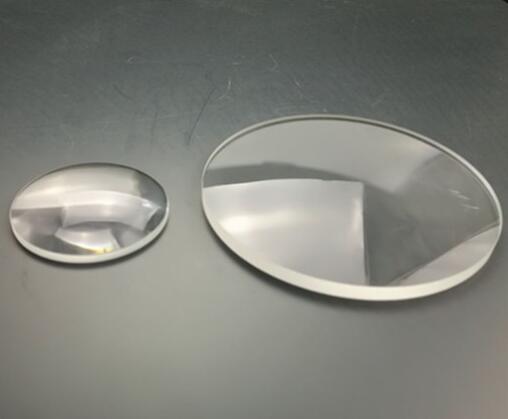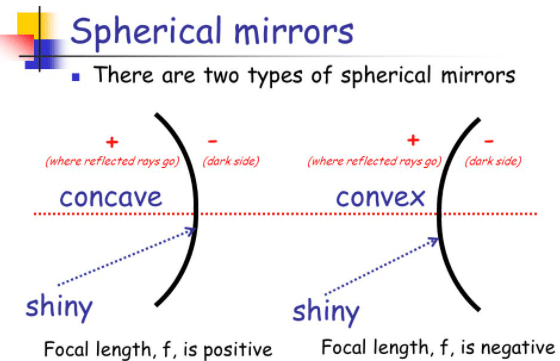A Basics of Optics (Ⅱ)
Sep. 08, 2022
How many types of spherical mirrors are in optics?
In this post, you are Going To learn the types of spherical mirrors and the Difference between Convex mirror and Concave mirror.
If you want to get benefits from this Post, you are at the Right Place.
Let's Dive right in.

Contents
● Spherical Mirrors Definition
● Types of mirrors
● Comparison: Convex mirror Vs Concave mirror
● Uses and Applications of Spherical Mirrors
Keep Reading…
What are Spherical Mirrors?

types of spherical mirrors
A mirror whose polished, reflecting surface is a part of a hollow sphere of glass or plastic is called a spherical mirror. In a spherical mirror, one of the two curved surfaces is coated with a thin layer of silver followed by a coating of red lead oxide paint. Thus, one side of the spherical mirror is opaque and the other side is a highly polished reflecting surface.
Types of spherical mirrors
Depending upon the nature of the reflecting surface, there are two types of spherical mirrors.
Concave Mirror
A spherical mirror whose inner curved surface is reflecting is called a concave mirror. In the concave mirror, the size of the image depends on the position of the object. Both virtual and real image can be formed by a concave mirror.
Convex Mirror
A spherical mirror whose outer curved is reflecting is called a convex mirror. In the convex mirror, the size of an image is always smaller than the object. Only a virtual and erect image is formed by a convex mirror.
Difference between convex and concave mirror in tabular form
| convex mirror | concave mirror |
| 1: Its outer surface is reflecting. | 1: Its inner surface is reflecting. |
| 2: Its principal focus is behind the mirror, and virtual. | 2: Its principal focus is in front of a mirror, and real. |
| 3: It forms a virtual image. | 3: It forms a real and virtual image. |
| 4: Its focal length is negative. | 4: Its focal length is positive. |
| 5:It is used to get magnified images. | 5: It is used to get images of small sizes. |
Pole
It is the midpoint of the curved surface of a spherical mirror. It is also called the vertex.
Center of Curvature (C)
A spherical mirror is a part of a sphere. The center of this sphere is called the center of curvature.
Radius of Curvature (R)
It is the radius of the sphere of which a spherical mirror is a part.
Principle Axis
It is the line joining the center of curvature and pole of the spherical mirror.
The Principal focus (F)
After reflection from a concave mirror, rays of light parallel to the principal axis converge to a point F. This point is called “The Principal Focus” of the mirror. Hence, Concave mirrors are also called converging mirrors. Since rays actually pass through this point, therefore, it is called the real focus.
In the case of a convex mirror, rays parallel to the principal axis after reflection appear to come from a point F situated behind the mirror. In other words, rays of light appear to diverge from F. This point is called the principal focus of the convex mirror. Convex mirrors are also called diverging mirrors. The principal focus of a convex mirror is the virtual focus because the reflected rays do not actually pass through it but appear to do so.
Focal length (f):
It is the distance from the pole to the principal focus measured along the principal axis. The focal length is related to the radius of curvature by f =R/2. This means that as the radius of curvature is reduced, so too is the focal length of the reflecting surface.
Reflection of Light by Spherical Mirrors
Like plane surfaces, spherical surfaces also reflect light following the two laws of reflection as stated for plane surfaces. Shows how light is reflected by the spherical surfaces of concave and convex mirrors according to the two laws of reflection.
Image Location by Spherical Mirror Formula
How can we tell about the nature of the image (whether the image is real or imaginary, inverted, or erect) formed in the mirror? How can we tell about the size of the image compared with the size of the object? To answer these questions, one method is a graphical or ray diagram. But, we can also answer these questions by using a mathematical formula called the mirror formula defined as:
Mirror formula is the relationship between object distance p, image distance q from the mirror, and focal length f of the mirror.
1/f = 1/p +1/q
Uses of spherical mirrors in daily life
● Spherical mirrors are used in reflecting telescope
● They are used in microscope
● used in vehicles
● used to see image
For more information, feel free to contact us.


















